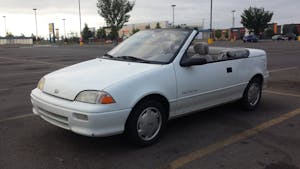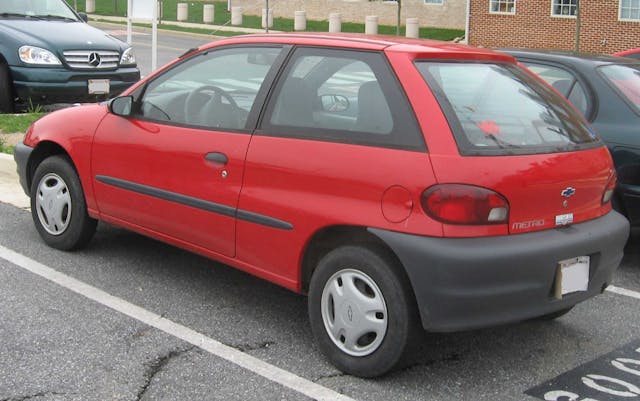There’s something refreshingly honest about this ’90s Chevy gas miser
It was Winter 2008. The economic crash that year was still nine months away, but the price of gas had crept up to three bucks a gallon.
So, I did something surprising—for me, anyway. I bought a 1999 Geo Metro. Actually, it was badged a Chevrolet, so I bought a Chevy Metro. Doubly surprising.
There was a certain odd logic to it. My car count had crept up to seven, a number that by current standards seems quaint, but I did have one kid in college and two more on the approach path. I didn’t want to sell my ’99 BMW Z3 M Coupe (and still haven’t), and I didn’t want to sell my ’82 Porsche 911SC (but eventually did, at exactly the wrong time), so the bone I threw to the dogs of reason was to sell my then-daily-driver ’97 BMW 318ti, which had only 78K on it, purchase a you-know-what box that got better gas mileage, and bank the difference.
The other part of the underlying motivation, though, was curiosity. As an engineer and a car nut, I wanted to know whether you needed to spend what then was substantial money to buy a used Prius in order to get over 40 mpg, or whether you could get similar numbers from the kind of cheap econobox that people used and threw away.
But even beyond the gas mileage metrics, I was curious about something. Consciously or not, most of us weigh six different factors when we think about buying a car: performance, appearance, safety, fuel economy, reliability, and passenger/cargo space. Occasionally, one of those six dials gets cranked up by social factors, marketing pressures, or one’s own internal compass, and it pushes the other factors into the background. As car nuts, many of us fixate on performance and can quote 0–60 times of any cool car built in the last 50 years. If you value appearance above all else, you wind up with a 1963 Jaguar Series 1 E-Type or a split-window ’Vette. The frequency-of-repair records in Consumer Reports cater to those who place a premium on reliability. The apogee of minivan sales was reached because of a desire by a large chunk of the population for passenger space. Trucks and full-sized SUVs are incredibly useful if you need to haul a lot of stuff and are willing to pay the penalty in fuel economy. I’d owned, at that time, a series of three beat-up older Suburbans, selected for their low cost and ability to haul my family, friends, and stuff to beach vacations, so I’d experienced what happens when you crank the “cheap and huge” knob up to 11. I wanted to see what it was like if you did it with the cheap and hyper-fuel-efficient knob.
There were other sub-compact cars with very small engines sold in the United States during the ’80s and ’90s—the Dodge/Plymouth Colt/Champ, for example, which was a Mitsubishi product—but the Geo Metro had a bigger niche, I think, due to Geo being a joint venture between GM and several Japanese automakers and the marketing of Geo as a Chevrolet subdivision.
The Metro was a Suzuki Cultus. These were originally built in Japan, but production then shifted to a Canadian plant that was part of Suzuki and GM’s joint venture for Geo. The first-generation cars began production in 1989 and were initially marketed in the U.S. as the Chevy Sprint, though the early ones were better known as the Suzuki Swift. The second gen was built 1995–2001 and was available as a three-door or five-door hatchback, a four-door sedan, and the ugliest little convertible built since the Nash Rambler. The engine choices were a 1.0-liter three-cylinder or a 1.3-liter four-cylinder, later increased to 1.4 liters. Beginning in 1998, the Geo nameplate was dropped, and the Metro was directly badged as a Chevy.

So, what I bought in 2008 was a ’99 Chevy Metro, in the gas mileage champ configuration—the two-door hatchback with the 1.0-liter three-cylinder 55-horsepower engine. It had throttle body fuel injection, which meant that there was a big device on top of the intake manifold that looked very much like a carburetor.
When I bought the car, my first challenge was that the “check engine” light was on. In Massachusetts, a car won’t pass inspection if that light is lit. I plugged in an OBDII code reader and pulled the code (P1250), looked it up online, and learned that it implicated the Early Fuel Evaporation (EFE) heater on the intake manifold. I read, then looked at the car, and sure enough, between the throttle body and the intake manifold was a ceramic heater that looked like a spacer with an electrical plug in it. The device is intended to help vaporize the fuel when the engine is cold. Due to age, heat, and vibration, the ceramic will crack. I read on Metro enthusiast forums (yes, Metro enthusiast forums!) that the heater was no longer available, and that every used one in a junkyard was likely to be cracked. Damn, I thought; how am I supposed to get this car inspected?
Then I read that, with this code, the car’s computer isn’t that particular about the resistance value of the heater, that all that computer is looking for is that there’s a current draw, and that even connecting a light bulb to it will fool it into thinking that the heater is there. I poked around in my stash of BMW taillight and directional bulbs, cobbled together a socket with wire leads, spliced them into the connector powering the heater, started the car, saw the light come on as the car’s computer powered the “heater,” then watched it go out as the car warmed up. Sure enough, the check engine light went out and stayed out. I got the car inspected. I wound up leaving the light bulb installed just because I enjoyed seeing it glow in the panel gap between the hood and the roof when I’d start the car.
Once I got the Metro legal, I tried to fix a few odds and ends on the car. The shift linkage was incredibly sloppy. I looked up and ordered the required little nylon bushings, as I’ve done dozens of times on cars, but when I jacked it up to replace them, I found that the undercarriage of the car had the coating of surface rust you’d expect of any lifelong New England car. That’s normally not a big deal; I just use the requisite combination of penetrating oil and heat to loosen stuck fasteners. However, the metal proved to be so thin and light that the torque I’d normally apply caused things to bend. I stopped and drove the car with a sloppy shifter. I guess that I should’ve been surprised considering that the car weighed barely 300 pounds more than my fiberglass-bodied Lotus Europa.
Once I began driving the Metro, though, it wasn’t that bad. It certainly wasn’t fast, but it wasn’t diesel Vanagon slow either (yes, I owned one, and it continues to be the metric for gosh-I-can’t-believe-a-vehicle-is-this-slow slowness). The Metro was a Japanese purpose-built econobox. It had a certain Zen about it—a buzzy cheap Zen, but a Zen nevertheless.
I used it one weekend to take my middle son Kyle on a college visit. This gave me the chance to benchmark the gas mileage. I drove it from Boston down to Rutgers in New Jersey at 55 mph, and I’m here to tell you, it delivered 53 miles per gallon. On the return trip, I allowed myself to drive closer to the traffic speed, hewing to about a 70-mph average, and the fuel economy was still a very respectable 45 mpg.
That fall, the economy crashed, and the price of gas spiked to nearly $4.50 a gallon. Suddenly, use-em-and-crush-em economy cars were hot commodities, and the Metro led the pack. I felt like a genius.

I used the car for the better part of a year, then to no one’s surprise, I got tired of it. I only had a four-mile commute, so it’s not like my fuel bill in a 25-mpg BMW was huge anyway. I gave the Metro to my older son Ethan, who was in college at UMass Amherst. At first, he was horrified. He’d previously had the run of my BMW 318ti, then my ’99 E39 sport wagon. When he realized he was getting this, and that there was no way to talk me out if it in favor of some other car, he accused me of … how shall I put this? … intentionally trying to ensure that my wife and I would have no grandchildren.
But as a poor college student, he grudgingly came to appreciate the economics of the Metro. He called me one weekend and said, “Dad, I just drove from Boston to New York to Amherst. I think I used 10 bucks worth of fuel!”
Now, my son Ethan has never been someone who has cared for cars (which was part of the reason to give him the relatively disposable Metro). One weekend when he came home from college, I had to move the car in the driveway. I got in it and was nearly flattened by an unholy sour stench. It turned out that he’d spilled a yogurt smoothie on the rug and never thoroughly cleaned it, and over time, it did just what you’d think it would do. If the car was left in hot weather with the windows up, the rancid odor was overpowering.
When Ethan graduated and moved away, the Metro returned to my automotive fold. Gas prices had eased somewhat but were still high, and the demand for the car was still strong, even with the still very much present (though dissipated) sour dairy smell. A fellow bought it from me sight-unseen and flew up from New Jersey to drive it off.
These days, of course, with fuel prices unbelievably low, as a car nut it makes sense to swing the other way, indulge and buy the V-12 German luxo-barge of your dreams. And if you want something that gets great mileage, with the Prius now having been available in the U.S. for 20 years, inexpensive used ones are ubiquitous, so there’s no reason to subject yourself to the buzzy tuna-can vibe of the Metro. I think the odds are slim you’ll ever see it as a Hagerty appreciating classic, or on anyone’s “buy” list. But as an engineer who appreciates functionality, there was something refreshingly honest about the Metro. The cartoon character Popeye used to say, “I yam what I yam.” The Metro was what it was, and I had a certain grudging respect for that.
***
Rob Siegel has been writing the column The Hack Mechanic™ for BMW CCA Roundel magazine for 34 years and is the author of five automotive books. His new book, Resurrecting Bertha: Buying back our wedding car after 26 years in storage, is available on Amazon, as are his other books, like Ran When Parked. You can order personally inscribed copies here.


